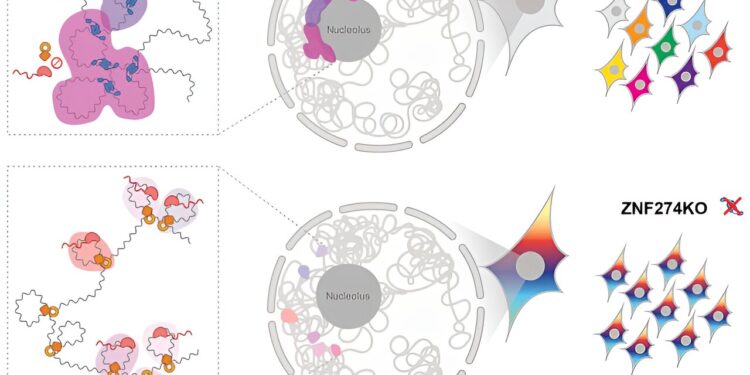Credit: Scientific advances (2024). DOI: 10.1126/sciadv.ado1662
In a discovery that sheds light on the complex mechanisms of gene regulation, EPFL scientists have discovered the essential role of the protein ZNF274 in maintaining certain groups of genes turned off by anchoring them to the cell nucleolus. The study is published in Scientific advances.
Our DNA is not just a string of genes; it is a complex and dynamic structure where the spatial organization within the nucleus plays a crucial role in the regulation of which genes are activated or deactivated. One of the key players in this complex process is the nucleolus, a spherical structure located inside the cell’s nucleus, the compartment where gene expression is orchestrated and executed.
The nucleolus is primarily known as the site of production of ribosomes, which play a key role in protein manufacturing. However, recent studies have shown that the nucleolus is also involved in the regulation of gene expression.
Controlling gene activity
The nucleolus is surrounded by regions of the genome called nucleolus-associated domains (NADs), which harbor repressed or “silenced” genes. Scientists believe that NAD plays a key role in keeping genes arranged in clusters along chromosomes under tight control, which is essential for the proper functioning and development of cells. However, the mechanisms that target specific gene groups to NADs have remained largely mysterious.
Understanding how genes are repressed in these compartments is essential not only for basic biology, but also for understanding diseases in which gene repression goes wrong. For example, misregulation of gene clusters has been implicated in various developmental or psychiatric disorders and cancers.
The ZNF274 protein: The pattern of silent genes
A team of EPFL scientists, led by Martina Begnis and Didier Trono, discovered that a protein called ZNF274 helps control certain groups of genes, including those necessary for brain development, by locking them into specific parts of the cell where they remain silent. , ensuring that these genes only activate when they are supposed to.
How does ZNF274 do this? By serving as a bridge between the components of NAD and these groups of genes, which it recognizes because they carry a critical sequence motif. ZNF274 anchors target genes, including those involved in neuronal development, to NADs, thereby maintaining their repression.
Focus on the consequences of the absence of ZNF274
The researchers used a combination of CRISPR/Cas9 gene editing and advanced sequencing techniques to create cells lacking the ZNF274 protein, in which they could study the effects on gene expression and genome organization.
The absence of ZNF274 led to the activation of previously repressed groups of genes, for example those encoding protocadherins, essential for neuronal development. They also noticed changes in the structure of chromatin – the complex of DNA and proteins that forms chromosomes – leading to a change in the 3D genome architecture.
The study found that ZNF274 helps keep certain groups of genes turned off by attaching them to the nucleolus. When ZNF274 is absent, these genes become active when they should not.
The researchers also discovered that ZNF274 uses a specific part of it, called the SCAN domain, to contact the nucleolus. This connection keeps genes in “off” mode, preventing their accidental activation.
The study has broad implications for our understanding of gene regulation, providing insight into the fundamental processes that ensure correct gene expression during development.
It also suggests that disruptions in this system could contribute to developmental disorders and diseases such as schizophrenia and Prader-Willi syndrome, where gene regulation is known to be affected.
More information:
Martina Begnis et al, Lineage-specific gene clusters are anchored by ZNF274 in repressive perinucleolar compartments, Scientific advances (2024). DOI: 10.1126/sciadv.ado1662
Provided by the Ecole Polytechnique Fédérale de Lausanne
Quote: How a protein maintains silent gene groups in the cell nucleolus (September 27, 2024) retrieved September 27, 2024 from
This document is subject to copyright. Except for fair use for private study or research purposes, no part may be reproduced without written permission. The content is provided for informational purposes only.



